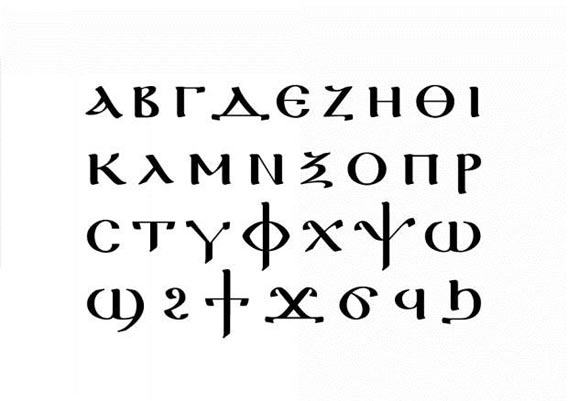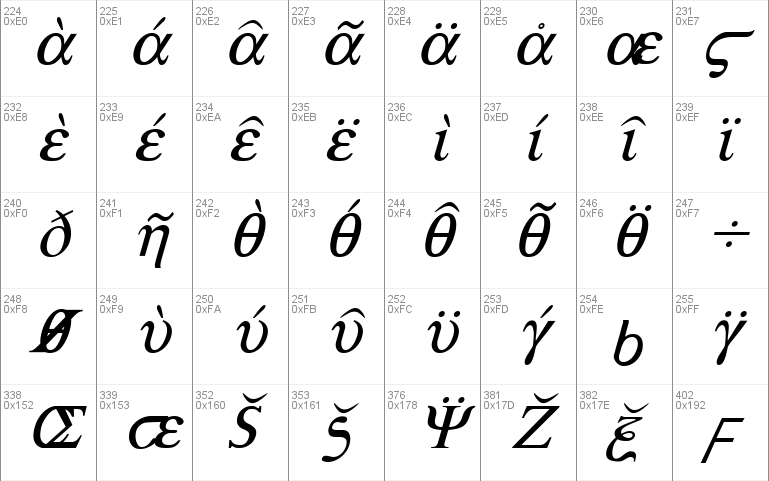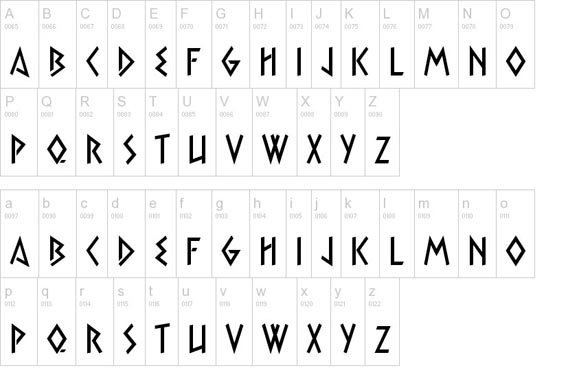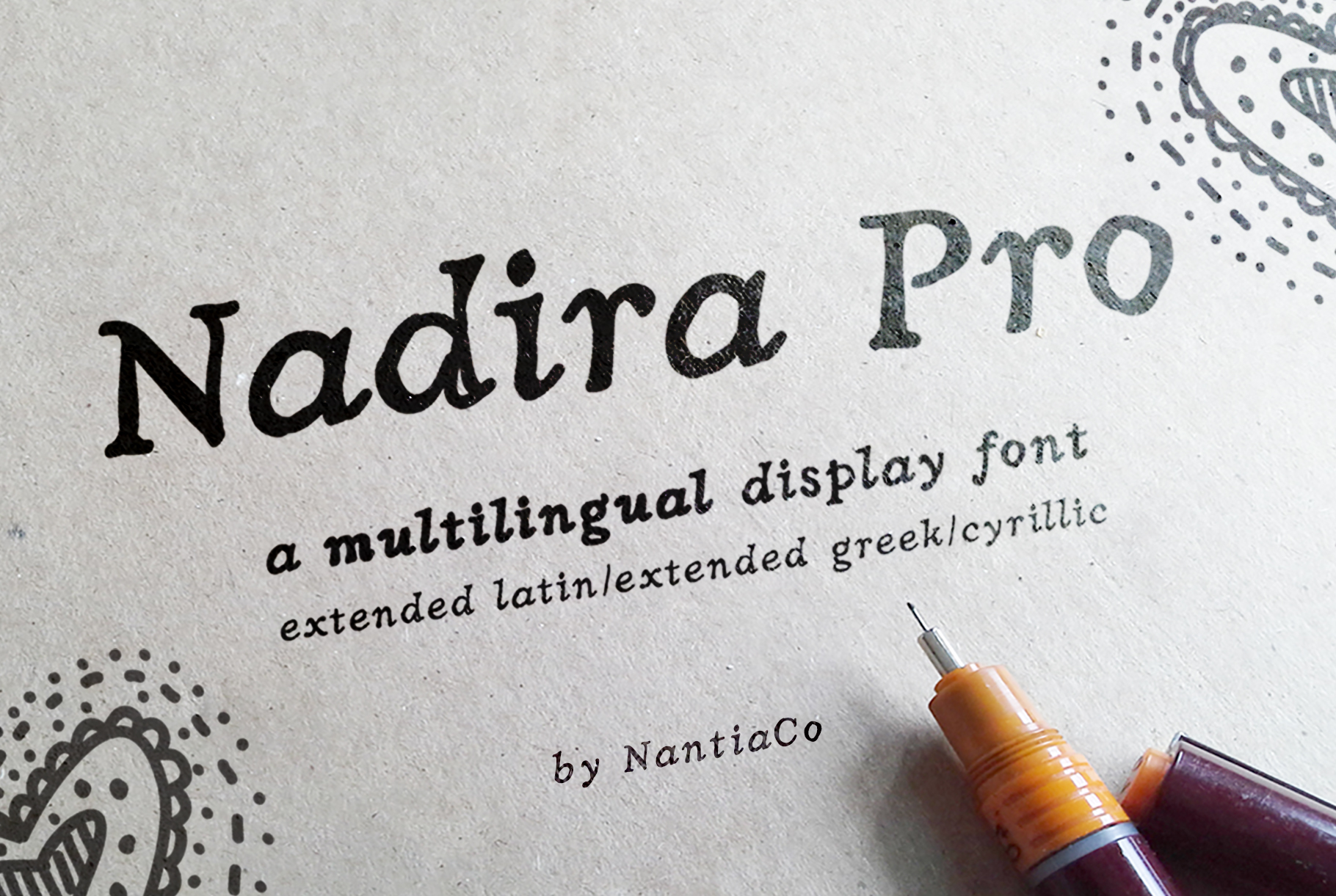- Fonts To Download For Mac
- Greek Fonts For Mac Free Downloads
- Greek Font Ttf
- Greek Fonts For Mac Free Download Windows 7
- Greek Font Text
- Free Greek Font: TekniaGreek We are pleased to give away our Greek font, TekniaGreek. It follows our standard mapping initiative. It is identical on the Macintosh.
- 52393 fonts in 25683 families. Download free fonts for Windows and Mac. The home of free fonts since 1998.
- Download Arial font for PC/Mac for free, take a test-drive and see the entire character set. Moreover, you can embed it to your website with @font-face support. Currency Symbols. Latin Extended-C. Latin Extended-D. Temporarily download this font to a printer or other output device to help print content. Any other use is.
Free Hebrew fonts (.ttf &.otf). Hebrew available in Windows and Mac OS X version. TrueType and OpenType fonts. Search from a wide range of typography fonts. Download Free greek fonts at UrbanFonts.com Our site carries over 30,000 PC fonts and Mac fonts. You can customize your experience with live font previews.
Arial Greek (arial.zip)
Times New Roman Greek (times.zip)
Avant Greek TrueType (avant.zip))

 Download the font file or files to your disk and execute the relative '.exe' to extract the appropriate fonts.
Download the font file or files to your disk and execute the relative '.exe' to extract the appropriate fonts. From the Control Panel, double-click on Fonts icon, and press the Add button.
Select the fonts that you would like to install and click OK.
Select the fonts that should be used by the browser for the Greek encoding.
Go to: Tools - Internet Options - Fonts. Select Greek in the 'Language Script' area.
At the Web-page font select a Greek one you have extracted e.g. Arial Greek and at the Fixed-width font select Courier New.
Select the language that should be used by the browser.
Go to: Tools - Internet Options - Languages. Add the greek language at the list and put it at the top.
Select a default encoding.
To do this, you need to select View - Encoding - Greek ISO, or View - Encoding - Greek (Windows). Also, if the Autoselect option is checked, uncheck it.
Greek font for Mac (mac_928.sit.hqx)
Downolad and decompress the file. After decompression place new fonts in the fonts folder, which is in your system folder.
Netscape (versions 4.5 and higher):
Select the fonts that should be used by the browser for the Greek encoding.
To do this, you need to select Edit - Preferences - Appearance - Fonts.
Here, you should change 'For the Encoding' to Greek,and select fonts (from the new installed) for the Variable Width Font and the Fixed Width Font. For the 'Sometimes a document will provide its own fonts.' option, select Use my default fonts, overriding document-specified fonts.
Select the language that should be used by the browser.
To do this, you need to select Edit - Preferences - Navigator - Languages.
Here, you should add the Greek language and put it on top of the list.
Select a default encoding.
To do this, you need to select View - Character Set - Greek ISO-8859-7. Also select View - Character Set - Set Default Encoding.
Microsoft Internet Explorer Versions 5.x:
Select the fonts that should be used by the browser for the Greek encoding.
Go to: Edit - Preferences - Languages/Fonts. Add Greek language in the list.
Select one font from those you've just installed at the fonts selections.
Select ISO 8859-7 as the default Character set.
Select a default encoding.
To do this, you need to select View - Character Set - Greek ISO 8859-7.
Windows Greek keyboard installation
Go to: Start -> Control Panel -> Regional and Langage options -> tab Languages -> button Details. You will probably have only English there, so if you do not see Greek, click on Add..., and select Greek from the list.
You should now see GR Greek Greek. There are various layouts available, highlight the line for Greek, and click on Properties, there you can select other Greek keyboard layouts, like Polytonic Greek (applicable only to Windows XP).
Before clicking the OK button, choose which key combination you want for the Switch languages option, I prefer Ctrl+Shift but you can have Left Alt+Shift. So select whichever you want and make sure that the 'Enable indicator in taskbar' option is checked. Also, depending on which language you will be using more often, you can chose to set one of the languages as the default (indicating which keyboard driver should be active when Windows starts up).
download Greek font for Linux
How to use the Greek keyboard:
Use Ctrl+Shift or Left Alt+Shift to switch between the English and Greek keyboards or any other installed keyboards. To type an accented vowel, press the ';' (semicolon) key and then the vowel (separately). To use the diaeresis (like umlaut) accent, press ':' (colon - that is, Shift+semicolon) before the vowel.
To use both diaeresis and accent on ι ( ΐ ) and υ (ΰ), press Right Alt+Shift+: before the vowel. To type ';' (the Greek question mark) and ':' (colon / ano-kato teleia) you need to press 'Q' and 'SHIFT-Q' respectively.
The Greek semicolon ('ano teleia') is missing as it was not included by ELOT in the Greek standards! There is a trick however to add it to your keyboard. From Word for Windows go to Insert -> Symbol -> and find the Greek semicolon symbol (8th line 7th character from the left) -> Select Shortcut Key -> In the field Press New Shortcut Key press the keys Ctrl+Shift+colon (the key immediately to the right of the 'L' key) -> Click Assign. This is it. From now on the Greek semicolon will appear on Word when you press Ctrl+Shift+colon.
In some applications, Left Alt+Shift may not switch keyboards. You may be able to manually switch the keyboard by clicking the 'En' or 'Gr' icon in the taskbar or select and use the alternative keyboard shortcut provided which is Ctrl+Shift.
Using the Greek keys
You can use a utility like Microsoft Visual keyboard if you are confused as to which English keys correspond to which Greek letters.
Microsoft Visual keyboard supports typing in more than one language on the same computer by showing you a keyboard for another language on your screen. You might use Visual Keyboard when you change your keyboard layout from one language to another. When you change keyboard layouts, the characters you see as you type might not correspond with your keyboard. Visual Keyboard lets you see the keyboard for the language you've switched to on your screen so that you can either click the keys on your screen or see the correct keys to press to enter text.
Displaying Greek text on a browser
In order for the Greek to be correctly displayed in a browser you must ensure that the <HEAD> section of the source code contains the following tag:
<meta http-equiv='Content-Type'>
or
<meta http-equiv='Content-Type'>
if you want to use Unicode encoding.
GREEK FONTS LINKS
How to view print and type in Greek for all platforms from Hellenic Resources Network
http://www.hri.org/fonts
Greek fonts
http://www.travelphrases.info/gallery/Fonts_Greek3.html
Adding Greek fonts
http://langintro.com/greek/common/howto.htm
Dealing with Greek Characters in Computers
http://www.softlab.ntua.gr/~sivann/xgrk/greek-zvr.html

LINGUIST List 11.2285, Word Processing in Greek
POLYTONIC GREEK FONTS
Free Greek fonts by Magenta (Canonica is polytonic)
Unicode Polytonic Greek for the World Wide Web
(750050) - Στα Windows 2000 υπάρχει η δυνατότητα εγκατάστασης πολυτονικού πληκτρολογίου.
Πώς θα εγκατασταθεί το πολυτονικό πληκτρολόγιο στα Windows XP
(750106) - Το άρθρο αυτό περιγράφει τη διαδικασία εγκατάστασης του πολυτονικού πληκτρολογίου στα Windows XP Home Edition ή στα Windows XP Professional Edition.
How to Use the Greek Polytonic System in Windows XP
Polytonic Greek is not a language itself but rather a representation form of the Greek Language. It is named Polytonic due to the use of multiple (poly-) diacritic marks, as opposed to Monotonic that uses a single (mono-) diacritic mark... download 1MB Word file
Χρήση πολυτονικών στα Microsoft Windows 2000/XP
(750052) - Οι εκδόσεις των Microsoft Windows (εκδόσεις 2000/XP) υποστηρίζουν πολυτονική Ελληνική γραφή (ψιλή, δασεία, περισπωμένη, υπογεγραμμένη, βαρεία, οξεία, κλπ.) και ακολουθεί το επίσημο Unicode(i) πρότυπο για τους ελληνικούς πολυτονικούς χαρακτήρες ...
Greek polytonic keyboard layout by Microsoft and by ellopos (You need Internet Explorer to see it).
Λήψη γραμματοσειρών (πολυτονικών και μονοτονικών) καθώς και οδηγών πληκτρολογίου για πολυτονικά
OTHER DOCUMENTS RELATING TO GREEK FONTS
Greek Documents Are Identified as Russian Instead of Greek (249966) - When Site Server Search indexes Greek documents that are not explicitly tagged as Greek, Search may incorrectly identify the documents as Russian. |
| Accented Greek Characters Are Not Being Created |
(164432) - When using the Greek input locale, accented Greek characters are not being created correctly. |
| Print Server Does Not Support Greek Characters |
(165246) - The SNA Print Server does not support printing of Greek characters. |
| Greek Letter Sigma Teliko Is Not Displayed Properly in NetMeeting |
(263114) - In the Options dialog box in NetMeeting, the Greek letter 'sigma teliko' is not properly displayed in the Directory box, but is displayed correctly in the drop-down list. |
| Using Greek Keyboard from Command Line Renders Wrong Characters |
(265810) - When you select Greek as your user locale on your Windows 2000-based computer and then attempt to use the keyboard in Virtual Dos Mode, you receive the following error message: One or more CON code pages invalid for the given keyboard code. The... |
| Greek Keyboard Has Incorrect Mapping for MS-DOS-Based Programs |
(291326) - If you are using the Greek system locale with the Greek standard and Latin keyboard, and you use MS-DOS-based programs, some of the keys may not work correctly. |
| Print Screen in 3270 Applet Does Not Support Greek Code Page |
(194621) - When using the Print Screen feature within the 3270 applet, some Greek characters may not print correctly even though they are displayed correctly within the applet. |
| Print Screen in 5250 Applet Does Not Support Greek Code Page |
(194764) - When you use the Print Screen feature within the 5250 applet, some Greek characters may not print correctly, although they are displayed correctly within the applet. |
| Updated Multinational Ext And Greek Symbol Fonts Available |
(134082) - The Office 7.0 for Windows 95 Resource Kit includes updated versions of the Multinational Ext And Greek Symbol fonts that were originally made available with the WordPerfect 5.x/6.0 Supplemental Converter Kit for Word 6.x for Windows. These fonts are... |
| XFOR: Greek Outlook Client Cannot Send Message to MS Mail User |
(175235) - When you use the Greek Outlook Client to send a message to a Microsoft Mail user through Microsoft Exchange, you may receive the following non-delivery report (NDR): Delivery failed to MS:MICROSOFT/KESWICK/MARKCAT. Reason: 0 (transfer failed)... |
| Greek Characters Not Printed with Certain PCL Printer Drivers |
(260577) - Greek characters on a Web page may be displayed correctly, but may not be printed if you use any of the following Hewlett-Packard (HP) Printer Control Language (PCL) printer drivers: HP LaserJet 4Si HP LaserJet 4Si MX HP PCL Color LaserJet 5/5M HP... |
| Problems Displaying Underscored Greek Characters in 3270 Applet |
(194933) - When the SNA Client 3270 emulator is configured to use the Greek() code page, certain font sizes may result in the underscore from underlined characters not being removed when the screen display is refreshed. |
| Lowercase Greek Letters That You Insert by Using an East Asian IME Are Converted to Uppercase Letters |
(827869) - When you use an East Asian Input Method Editor (IME) to insert lowercase Greek letters in your Microsoft Office Visio 2003 drawing, you may find that the lowercase letters are automatically converted to uppercase letters. For example, if you use the... |
| Changing the Keyboard in Arabic, Hebrew, & Greek Windows |
(123145) - In the Arabic, Hebrew, and Greek versions of Windows version 3.1, you can can change the keyboard language dynamically. The WM_KEYBOARD_CHANGE and WM_LANGUAGE_CHANGE messages are sent to applications to inform them of the language change.... |
| Applet Does Not Display Greek and Central European Characters |
(165220) - The 3270 applet for the Windows 95 and Windows NT SNA Server clients reports that it cannot find the Courier New Greek font even though the font is installed. The same error message occurs when trying to display Central European characters. |
| Greek Symbols Appear Instead of Selected Fonts in Windows 3.1 |
(84245) - Fonts display as Greek symbols in Microsoft Windows version 3.1. This font-mapping problem may occur only in certain applications or after choosing certain options within an application. |
| XCON: No MTA Support for ISO 8859-7 (Greek) Character Set |
(193345) - Currently, there is no support for the ISO 8859-7 (Greek) character set built into the Exchange Server message transfer agent (MTA). This may be an issue when communicating with systems using ISO 8859-7. |
| The Hard Disk Label May Be Garbled in My Computer |
(227548) - If you upgrade a Microsoft Windows 98-based computer that is configured to use the Greek language (code page 737) to Windows 2000 with Greek language settings, the hard disk labels in My Computer that contained Greek characters may not be displayed... |
| WD97: Square Boxes in Central European, Russian, or Greek Document |
(163813) - If you open a Microsoft Word document that was created using a Central European, Russian, or Greek version of Microsoft Word, the text of the document may appear as square boxes when you open the document in the U.S. version of Word 97. In rare cases,... |
| INF: List of Windows International Code Pages for Windows 3.1 |
(131421) - The following is a list of the Windows code pages for the international versions of Microsoft Windows version 3.1 operating system. Language Code Page ------------------------------- Arabic 1256 Hebrew 1255 United States 1252 (and West European) Greek... |
| XCON: IMC Might Use the Wrong Code Page |
(157008) - The Microsoft Exchange Internet Mail Connector (IMC) might use the wrong code page for the Greek, Turkish, Hebrew, Arabic, Baltic, and Thai languages. |
| Cyberbit Unicode Font Does Not Return Correct Charset |
(162157) - Windows NT does not return the correct character set (charset) information for the Cyberbit unicode font. For example, an application attempts to map to one of the multiple character sets of this font, such as Greek, but Windows NT is unable to find... |
| INFO: UTF8 Support |
(175392) - UTF8 is a code page that uses a string of bytes to represent a 16-bit Unicode string where ASCII text (<=U+007F) remains unchanged as a single byte, U+0080-07FF (including Latin, Greek, Cyrillic, Hebrew, and Arabic) is converted to a 2-byte sequence,... |
| Some Character Sets Are Not Supported for OCR by the TIFF Index Filter |
(283950) - When you perform optical character recognition (OCR) on Tagged Image File Format (TIFF) files during indexing, the TIFF Index Filter only recognizes English, European, Cyrillic, and Greek character sets. It does not recognize other complex script... |
| 'Can’t Save File' After Changing Regional/Keyboard Setting |
(163393) - You get the following error message when trying to save a file in Word: Cannot save the file. '<path><filename>' is not a valid filename. This error will occur when the following conditions are true: Your Windows 95 Regional Settings are set to Greek... |
- Accents (partial)
- Accents (full)
- Euro
- Smilies
- Card symbols
- Music
- Accents (partial)
- Accents (full)
- Euro
- Smilies
- Card symbols
- Music
- Accents (partial)
- Accents (full)
- Euro
- Card symbols
- Music
- Accents (partial)
- Accents (full)
- Euro
- Smilies
- Card symbols
- Music
- Accents (partial)
- Accents (full)
- Euro
- Smilies
- Card symbols
- Music

Fonts To Download For Mac
- Accents (partial)
- Euro
- Smilies
- Card symbols
- Music
Greek Fonts For Mac Free Downloads
- Accents (partial)
- Accents (full)
- Euro
- Accents (partial)
- Accents (full)
- Euro
- Smilies
- Card symbols
- Music
Greek Font Ttf
- Accents (partial)
- Accents (full)
- Euro
- Card symbols
- Music
Greek Fonts For Mac Free Download Windows 7
- Accents (partial)
- Euro
- Card symbols
- Music
Greek Font Text
- 1-10 of 325 results